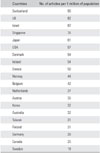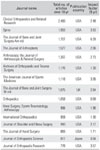Abstract
Background
This study was undertaken to investigate the trends of orthopedic publications during the last decade, and to document the country of origin, journal, funding source, and language of contribution using PubMed.
Methods
Orthopedic articles published between 2000 and 2009 were retrieved from PubMed using the following search terms: "orthopaedic[Affiliation] AND ("2000/1/1"[PDAT]: "2009/12/31"[PDAT])" and "orthopedic[Affiliation] AND ("2000/1/1"[PDAT]: "2009/12/31"[PDAT])." The articles were downloaded in XML file format, which contained the following information: article title, author names, journal names, publication dates, article types, languages, authors' affiliations and funding sources. These information was extracted, sorted, and rearranged using the database's management software. We investigated the annual number of published orthopedic articles worldwide and the annual rate of increase. Furthermore, the country of publication origin, journal, funding source, and language of contribution were also investigated.
Results
A total of 46,322 orthopedic articles were published and registered in PubMed in the last 10 years. The worldwide number of published orthopedic articles increased from 2,889 in 2000 to 6,909 in 2009, showing an annual increase of 384.6 articles, or an annualized compound rate of 10.2%. The United States ranked highest in the number of published orthopedic articles, followed by Japan, the United Kingdom, Germany, and the Republic of Korea. Among the orthopedic articles published worldwide during the last 10 years, 37.9% pertained studies performed in the United States. Fifty-seven point three percent (57.3%) of articles were published in journals established in the United States. Among the published orthopaedic articles, 4,747 articles (10.2%) disclosed financial support by research funds, of which 4,688 (98.8%) articles utilized research funds from the United States. Most articles were published in English (97.2%, 45,030 articles).
Conclusions
The number of published orthopedic articles has been increasing over the last decade. The number of orthopedic articles, journals publication, and funding sources were dominated by research conducted in the United States, while share and growth of Asian countries including Japan, the Republic of Korea, and China were notable.
Evidence-based medicine has caused a quantitative expansion in the number of published scientific articles. It aims to apply the best available evidence gained from scientific research to inform medical decision-making and improve treatment outcomes.1)
The ability to publish medical research encourages physicians to reach consensus on inconclusive medical issues and to keep medical knowledge and practice standards up-to-date. Physicians can readily obtain information from journals, due to the sheer quantity of published information and its accessibility via the Internet. In addition, the quantity and quality of published articles define the level of academic excellence of a country, a society, or an institution, which adds to the competitiveness of the medical field.
The increased interests in publication have also exploded in the orthopedic field. Previous studies provided country rankings of orthopedic publications in major orthopedic journals.2,3) However, orthopedic articles are published in many journals types, and not all of these are orthopedic-specific journals.
The aim of this study was to investigate the worldwide trends in orthopedic articles published between 2000 and 2009, and to document the country of research origin, journal, funding source and language of contribution using PubMed.
The institutional review board of Seoul National University Bundang Hospital approved this study. Informed consent was waived because this study did not involve human subject.
Orthopedic articles were defined as those originated from the orthopedic department, the corresponding authors' affiliations included the words 'orthopaedic' or 'orthopedic.' The PubMed database was utilized to retrieve orthopedic articles. This database contains a digital archive of 4,800 biomedical and life sciences journals in 30 languages, which were selected by the National Library of Medicine's Literature Selection Technical Review Committee. These articles were selected on a worldwide basis for their scientific merit, validity, importance, originality, and contribution.4)
All orthopedic articles published between January 2000 and December 2009 were retrieved from PubMed in March 2010 using the following search terms: "orthopaedic[Affiliation] AND ("2000/1/1"[PDAT]: "2009/12/31"[PDAT])" and "orthopedic[Affiliation] AND ("2000/1/1"[PDAT]: "2009/12/31"[PDAT])." The articles were downloaded in XML file format,5) which contained the following information: publication titles, authors' names, journal names, publication dates, article types, languages, authors' affiliations, and funding sources. These information was extracted, sorted, and rearranged using the database's management software. The accuracy of this software was determined by comparing with the interpretation of an author of this study (KML), who performed a manual analysis on randomly selected 50 articles.
The total annual number of published orthopedic articles worldwide was retrieved, and the annual rate of increase was calculated in absolute number of articles and as percentage compound rate to show proportional rate of increase. Highly ranked countries were selected in terms of total number of published orthopedic articles over 10 years, and the annual rate of increase was calculated. The ranking of countries by population and gross domestic product (GDP) per capita were also obtained.6)
The top 15 journals in terms of total number of published orthopedic articles over 10 years were selected. Their origin of publication and their 5-year impact factors based on the Thomson Reuters Journal Citation Report database were obtained (JCR 2008).7)
Funding sources and publication languages were obtained, and were provided for all published orthopedic articles over the 10-year period studied.
This study included all published articles and not merely a representative sample. Therefore, descriptive analysis was primarily used. To evaluate annual increases in the number of published articles, linear regression analysis was performed. Statistical significance was set at p < 0.05.
A total of 46,322 orthopedic articles published between January 2000 and December 2009 were identified in PubMed. These articles were published in 1,796 journals. The worldwide number of annually published orthopedic articles tended to increase during the study period. For example, 2,889 articles were published in 2000 and 6,909 in 2009. The worldwide annual rate of increase was 384.6 articles (95% confidence interval [CI], 274.9 to 494.2), which translates into an annualized compound rate of 10.2%. Of the 46,322 published orthopedic articles, 17,569 originated from the United States, 7,791 from Japan, 5,028 from the United Kingdom, 2,114 from Germany, and 1,555 from the Republic of Korea. The annual rate of increase of orthopedic articles published was highest in the United States (98.6 articles per year), followed by the United Kingdom (35.8 articles per year), The Republic of Korea (35.8 articles per year), Germany (24.9 articles per year), and China (21.0 articles per year). In terms of proportional increase rate of orthopedic articles published, the Republic of Korea showed the highest rate (20.2%), followed by Italy (15.0%) and Canada (14.2%). The majority of the highly ranked countries showed significant annual increase of published orthopedic articles (Table 1).
The ranking of orthopedic articles published on a per capita basis differed quite markedly from the ranking based on the number of publications. Switzerland ranked highest in terms of number of publications per million population over the 10-year study period. Some other European countries also ranked highly on a per capita basis (Table 2). When multiple regression analysis was performed to assess the effect of population and GDP on orthopedic article production, neither country population (p = 0.098) nor GDP (p = 0.137) were found to contribute to publication volume significantly (R square 0.137, p = 0.199).
Over the past decade, 2,460 orthopedic articles were published in Clinical Orthopedics and Related Research, 1,993 in Spine, 1,707 in the Journal of Bone and Joint Surgery-American volume, 1,577 in the Journal of Arthroplasty, and 1,397 in the Journal of Arthroscopic and Related Surgery (Table 3). The majority of top 15 journals were published in the United States. However, country affiliations of the articles and journals were not necessarily proportionate (Table 4).
Of the 46,322 published orthopedic articles, 4,747 (10.2%) declared grants as funding source, of which 4,688 (98.8%) of the funded articles utilized research grants from the United States. The National Institutes of Health (NIH) supported 4,529 articles, and the National Institute of Arthritis and Musculoskeletal and Skin Diseases (NIAMS), NIH, United States Department of Health and Human Services (HHS) (respectively the national institute of arthritis and musculoskeletal and skin diseases, national institutes of health, department of health and human services) supported the publication of 2,751 articles, which ranked the highest in the list of funding sources.
Most articles were published in English (97.2%, 45,030 articles), followed by Chinese (660 articles), Japanese (478 articles), German (65 articles), and Hebrew (33 articles).
Worldwide orthopedic articles demonstrated volumetric expansion over the past 10 years, with an annual rate of increase of 384.6 articles, or 10.2%. The United States dominated the increase in terms of research and publications. The NIH appears to play an important supportive role. Most highly ranked countries were also found to show an increasing tendency annually.
This study has limitations that should be addressed before the implications of our results are discussed. First, published articles were presented as numbers published, and article qualities were not considered, although this should probably be evaluated by using impact factors. Second, information regarding research funding was obtained using the grant field and thus, various commercial and domestic funding sources may have been neglected. Third, the PubMed database includes journals exclusively published for domestic readerships in native languages and thus, the inclusion of these articles confounds their international counterparts. Fourth, some domestic journals may not require country name of the articles in their affiliation, which might have been omitted in evaluating the number of articles in each country.
The majority of orthopedic articles published worldwide during the last 10 years involved research performed in the United States, and the majority of orthopedic articles were published in journals established in the United States. Accordingly, the United States plays an important role in orthopedic research and publication, and US journals should consider adopting the role of international journals that set standard scientific verification and build consensus. On the other hand, the share and growth of Asian countries, including Japan, the Republic of Korea and China were found to be prominent. More investment and support are required for these countries to contribute to the increasing tendency of orthopedic publications and growth of orthopedic knowledge.
The number of orthopedic surgeons and domestic funding available for orthopedic research may have significantly impacted on orthopedic publication, but this information was not available. The effects of other factors, such as, the number of teaching hospitals, the introduction of new products or technologies and English proficiency,8) need to be determined by future studies.
In conclusion, this study revealed the current status and trends of orthopedic publications over a 10-year period. The authors sincerely hope that the information pubpresented herein will encourage orthopedic research, and provide useful information to enable policy-making and allocation of research funds.
Figures and Tables
Table 1
Annual Increase of Published Orthopedic Articles in Top 10 Orthopedic Research-Producing Countries

Table 2
Top 20 Countries That Produced Orthopedic Articles over the Last 10 Years in Terms of the Number of Published Orthopedic Articles per Capita

References
1. Timmermans S, Mauck A. The promises and pitfalls of evidence-based medicine. Health Aff (Millwood). 2005. 24(1):18–28.

2. Bosker BH, Verheyen CC. The international rank order of publications in major clinical orthopaedic journals from 2000 to 2004. J Bone Joint Surg Br. 2006. 88(2):156–158.

3. Rahman M, Sakamoto J, Fukui T. Japan's share of articles in orthopedics. J Orthop Sci. 2002. 7(6):607–609.

4. Fact sheets: about the NLM [Internet]. National Library of Medicine. 2011. cited 2010 Mar 6. Bethesda: National Library of Medicine;Available from: http://www.nlm.nih.gov/pubs/factsheets/factsubj.html.
5. Wilson MP, Itagaki MW. Characteristics and trends of published emergency medicine research. Acad Emerg Med. 2007. 14(7):635–640.

6. The world factbook [Internet]. Central Intelligence Agency. 2011. cited 2010 Mar 6. Washington: Central Intelligence Agency;Available from: https://www.cia.gov/library/publications/the-world-factbook/index.html.
7. Journal Citation Reports 2008 [Internet]. Thomson Reuters. 2009. cited 2009 Aug 7. Philadelphia: Thomson Reuters;Available from: http://scientific.thomson.com/products/jcr/.




 PDF
PDF ePub
ePub Citation
Citation Print
Print




 XML Download
XML Download